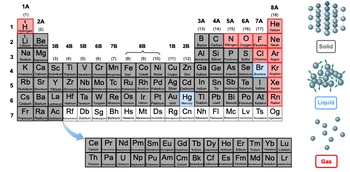As we delve into the periodic table, it's essential to understand how elements exist in different states of matter at standard room temperature (approximately 25 degrees Celsius) and standard pressure (1 atmosphere). The three primary states are solids, liquids, and gases, each characterized by the arrangement and movement of their molecules.
In solids, molecules are tightly packed and locked in place, resulting in a fixed shape and volume. This rigidity means that solids do not conform to the shape of their container. For example, a block of ice retains its shape regardless of the container it is placed in.
Liquids, on the other hand, have molecules that are close together but can move around more freely. This allows liquids to take the shape of their container while maintaining a constant volume. For instance, if you have 10 mL of water in a 25 mL container, the water will fill the bottom of the container but will not occupy the entire volume.
Gases exhibit a different behavior; their molecules are spaced far apart, which allows them to expand and fill both the shape and volume of their container. This property is crucial in understanding gas behavior in various applications.
When examining the periodic table, most elements are found in solid form, such as lithium, zinc, and sulfur. A few elements, like hydrogen, nitrogen, oxygen, and chlorine, exist as gases, with the noble gases in group 8A being notable examples. The rarest state is liquid, with only two elements—mercury and bromine—existing as liquids under standard conditions.
Additionally, some elements, particularly those in the seventh row (from francium to oganesson), are synthetically produced in laboratories. Due to their high atomic masses and instability, their state of matter at standard temperature and pressure is unpredictable, which is why they are not assigned a specific state.
Understanding these states of matter and their properties is fundamental in chemistry, as it helps explain how different elements behave under various conditions.


